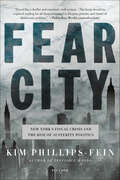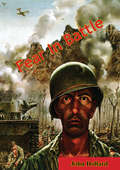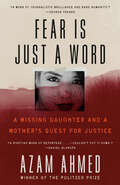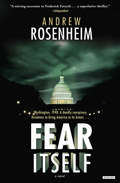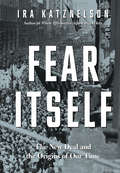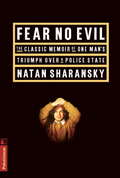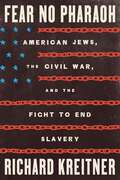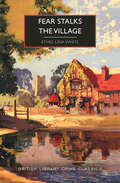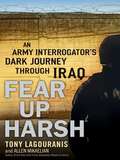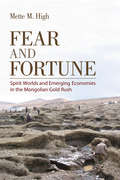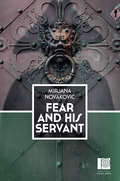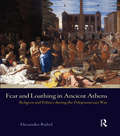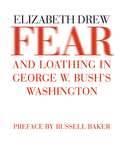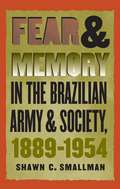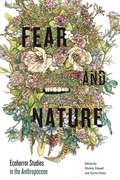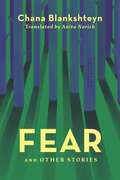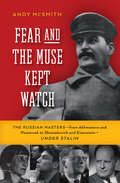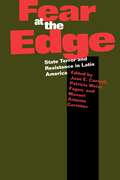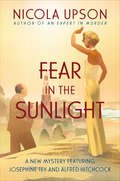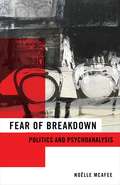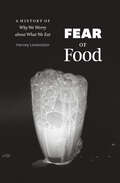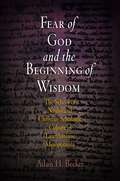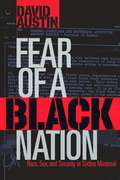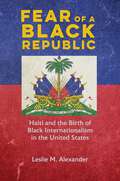- Table View
- List View
Fear City: New York's Fiscal Crisis and the Rise of Austerity Politics
by Kim Phillips-FeinPULITZER PRIZE FINALISTAn epic, riveting history of New York City on the edge of disaster—and an anatomy of the austerity politics that continue to shape the world todayWhen the news broke in 1975 that New York City was on the brink of fiscal collapse, few believed it was possible. How could the country’s largest metropolis fail? How could the capital of the financial world go bankrupt? Yet the city was indeed billions of dollars in the red, with no way to pay back its debts. Bankers and politicians alike seized upon the situation as evidence that social liberalism, which New York famously exemplified, was unworkable. The city had to slash services, freeze wages, and fire thousands of workers, they insisted, or financial apocalypse would ensue.In this vivid account, historian Kim Phillips-Fein tells the remarkable story of the crisis that engulfed the city. With unions and ordinary citizens refusing to accept retrenchment, the budget crunch became a struggle over the soul of New York, pitting fundamentally opposing visions of the city against each other. Drawing on never-before-used archival sources and interviews with key players in the crisis, Fear City shows how the brush with bankruptcy permanently transformed New York—and reshaped ideas about government across America.At once a sweeping history of some of the most tumultuous times in New York's past, a gripping narrative of last-minute machinations and backroom deals, and an origin story of the politics of austerity, Fear City is essential reading for anyone seeking to understand the resurgent fiscal conservatism of today.
Fear In Battle
by Donald Horton John DollardJohn Dollard (1900-1980) was a psychologist and social scientist best known for his studies on race relations in America. From 1942 to 1945 he served as a consultant in the Morale Services Division the United States Department of War, during which time he and fellow psychologists at Yale University's Institute of Human Relations produced a study titled "Fear and Courage under Battle Conditions." The study investigated fear and morale of soldiers in modern combat conditions. With the active assistance of the Veterans of the Abraham Lincoln Brigade interviews with Lincoln Brigade veterans were carried out and a questionnaire distributed. Three hundred veterans who had served as volunteers with the Abraham Lincoln Brigade during the Spanish Civil War replied and became the research subjects for the study.This book presents the findings from this intensive study for the purposes of military value.
Fear Is Just a Word: A Missing Daughter, a Violent Cartel, and a Mother's Quest for Vengeance
by Azam AhmedA riveting true story of a mother who fought back against the drug cartels in Mexico, pursuing her own brand of justice to avenge the kidnapping and murder of her daughter—from a global investigative correspondent for The New York Times&“Azam Ahmed has written a page-turning mystery but also a stunning, color-saturated portrait of the collapse of formal justice in one Mexican town.&”—Steve Coll, Pulitzer Prize–winning author of Directorate SFear Is Just a Word begins on an international bridge between Mexico and the United States, as fifty-six-year-old Miriam Rodríguez stalks one of the men she believes was involved in the murder of her daughter Karen. He is her target number eleven, a member of the drug cartel that has terrorized and controlled what was once Miriam&’s quiet hometown of San Fernando, Mexico, almost one hundred miles from the U.S. border. Having dyed her hair red as a disguise, Miriam watches, waits, and then orchestrates the arrest of this man, exacting her own version of justice.Woven into this deeply researched, moving account is the story of how cartels built their power in Mexico, escalated the use of violence, and kidnapped and murdered tens of thousands. Karen was just one of the many people who disappeared, and Miriam, a brilliant, strategic, and fearless woman, begged for help from the authorities and paid ransom money she could not afford in hopes of saving her daughter. When that failed, she decided that &“fear is just a word,&” and began a crusade to track down Karen&’s killers and to help other victimized families in their search for justice.What do people do when their country and the peaceful town where they have grown up become unrecognizable, suddenly places of violence and fear? Azam Ahmed takes us into the grieving of a country and a family to tell the mesmerizing story of a brave and brilliant woman determined to find out what happened to her daughter, and to see that the criminals who murdered her were punished. Fear Is Just a Word is an unforgettable and moving portrait of a woman, a town, and a country, and of what can happen when violent forces leave people to seek justice on their own.
Fear Itself: A Novel (The Jimmy Nessheim Novels #1)
by Andrew RosenheimA homegrown Nazi conspiracy threatens to destroy America in this historical FBI thriller: &“A stirring successor to Frederick Forsyth&” (The Independent). Washington, DC, 1940. Jimmy Nessheim, a young special agent in the fledgling FBI, is assigned to infiltrate a new German American organization known as the Bund. Ardently pro-Nazi, the Bund is conspiring to sabotage American efforts against Adolf Hitler. But Nessheim&’s investigation soon uncovers something far more sinister—and it leads directly to the White House. Drawn into the rarified world of Washington&’s high society, Nessheim is caught in a web of political intrigue, secret lives, and a lethal plot that could rewrite history. With sharp wit and a keen eye for period detail, author Andrew Rosenheim brings to life an America at the crucial period before it entered World War II. He seamlessly weaves into the narrative larger-than-life figures such as J. Edgar Hoover, Clyde Tolson, and Lucy Mercer Rutherford, as well as historical events like the 1939 pro-Nazi rally held at New York City&’s Madison Square Garden.
Fear Itself: The New Deal and the Origins of Our Time
by Ira Katznelson"A powerful argument, swept along by Katznelson's robust prose and the imposing scholarship that lies behind it."--Kevin Boyle, New York Times Book Review A work that "deeply reconceptualizes the New Deal and raises countless provocative questions" (David Kennedy), Fear Itself changes the ground rules for our understanding of this pivotal era in American history. Ira Katznelson examines the New Deal through the lens of a pervasive, almost existential fear that gripped a world defined by the collapse of capitalism and the rise of competing dictatorships, as well as a fear created by the ruinous racial divisions in American society. Katznelson argues that American democracy was both saved and distorted by a Faustian collaboration that guarded racial segregation as it built a new national state to manage capitalism and assert global power. Fear Itself charts the creation of the modern American state and "how a belief in the common good gave way to a central government dominated by interest-group politics and obsessed with national security" (Louis Menand, The New Yorker).
Fear No Evil
by Natan SharanskyTemperamentally and intellectually, Natan Sharansky is a man very much like many of us--which makes this account of his arrest on political grounds, his trial, and ten years' imprisonment in the Orwellian universe of the Soviet gulag particularly vivid and resonant. Since Fear No Evil was originally published in 1988, the Soviet government that imprisoned Sharansky has collapsed. Sharansky has become an important national leader in Israel--and serves as Israel's diplomatic liaison to the former Soviet Union! New York Times Jerusalem Bureau Chief Serge Schmemann reflects on those monumental events, and on Sharansky's extraordinary life in the decades since his arrest, in a new introduction to this edition. But the truths Sharansky learned in his jail cell and sets forth in this book have timeless importance so long as rulers anywhere on earth still supress their own peoples. For anyone with an interest in human rights--and anyone with an appreciation for the resilience of the human spirit--he illuminates the weapons with which the powerless can humble the powerful: physical courage, an untiring sense of humor, a bountiful imagination, and the conviction that "Nothing they do can humiliate me. I alone can humiliate myself. "
Fear No Pharaoh: American Jews, the Civil War, and the Fight to End Slavery
by Richard Kreitner"Despite their own legacy of torment in Egypt, Jews in the U.S. varied in their attitudes toward the slave system, even after it provoked secession and rebellion in their new promised land. This discomfiting anomaly has been probed by scholars . . . but the topic has never been dissected with the depth, panache and feel for character that animate Mr. Kreitner’s revelatory Fear No Pharaoh . . . [An] engrossing book." —Harold Holzer, The Wall Street Journal“Riveting . . . While surfacing fascinating new details . . . Kreitner also points to intriguing ways in which the slavery debate spurred reflection on assimilation vs. insularity that defined the next century of Jewish American thought. Readers will be engrossed.” —Publisher's Weekly (starred review)A dramatic history of how American Jews reckoned with slavery—and fought the Civil War.Since ancient times, the Jewish people have recalled the story of Exodus and reflected on the implications of having been slaves. Did the tradition teach that Jews should speak out against slavery and oppression everywhere, or act cautiously to protect themselves in a hostile world?In Fear No Pharaoh, the journalist and historian Richard Kreitner sets this question at the heart of the Civil War era. Using original sources, he tells the intertwined stories of six American Jews who helped to shape a tumultuous time, including Judah Benjamin, the brilliant, secretive lawyer who became Jefferson Davis’s trusted confidante; Morris Raphall, a Swedish-born rabbi who defended slavery as biblically justified; and Raphall's rival rabbis—the celebrated Isaac Mayer Wise, who urged Jews to stay out of the slavery controversy to avoid attracting attention, and David Einhorn, whose fiery sermons condemning bondage led to a pro-slavery mob threatening his life. We also meet August Bondi, a veteran of Europe’s 1848 revolutions, who fought with John Brown in “Bleeding Kansas” and later in the Union Army, and the Polish émigré Ernestine Rose, a feminist, atheist, and abolitionist who championed “emancipation of all kinds.”As he tracks these characters, Kreitner illuminates the shifting dynamics of Jewish life in America—and the debates about religion, morality, and politics that endure to this day.
Fear Stalks the Village (British Library Crime Classics)
by Ethel Lina WhiteIt was a model English village, filled with flowers, Tudor cottages, and cobbled streets. Joan Brook loved working there as a companion to Lady d'Arcy, living in the huge mansion with its surrounding park. And small though the village was, it was not too small for Joan to have found a man there whom she could love. Suddenly the peaceful surface of life there is shattered as a poisonous letter is received by the town's most saintly citizen. It is followed by others; no one is safe from the anonymous letter writer. And the letters bring death. In the anguished days that follow, Joan realizes her own danger. For to receive on of these letters could mean the end of her love - and her life!
Fear Up Harsh
by Tony Lagouranis Allen Mikaelian"Something really bad happened here. " So begins Army interrogator Tony Lagouranis's first briefing at Abu Ghraib. While Lagouranis's training stressed the rules of the Geneva Conventions, once in Iraq, he discovered that pushing the legal limits of interrogation was encouraged. Under orders, he-along with numerous other soldiers-abused and terrorized Iraqis by adding "enhancements" like dogs, hypothermia, and other techniques to "Fear Up Harsh"-the official tactic designed to frighten prisoners into revealing information. And he saw others do far worse. The first Army interrogator to publicly step forward and break the silence surrounding these tactics, Lagouranis reveals what went on in Iraqi prisons- raising crucial questions about American conduct abroad. .
Fear and Fortune: Spirit Worlds and Emerging Economies in the Mongolian Gold Rush
by Mette M. HighMongolia over the last decade has seen a substantial and ongoing gold rush. The widespread mining of gold looks at first glance to be a blessing for a desperately poor and largely pastoralist country where people's lives were disrupted by the end of the USSR and tens of millions of livestock were killed in devastating droughts in the early 2000s. Volatility and uncertainty as well as political and economic turmoil led many people to join the hopeful search for gold. This activity, born out of uncertain times, poses an intense moral problem; in the "land of dust," disturbing the ground and extracting the precious metal is widely believed to have calamitous consequences. With gold retaining strong ties to the landscape and its many spirit beings, the fortune of the precious metal is inseparable from the fears that surround mining. Tracing the continuities and discontinuities between human and nonhuman worlds, Mette M. High follows the paths of gold as it is excavated and converted into "polluted money," entering local shops and Buddhist monasteries, joining the illegal gold trade, and returning as "renewed" money for the "big bosses" of the gold mines.High has done several years of fieldwork in Mongolia, spending time with the "ninjas," as the miners are known locally, as well as the people who disapprove of their illegal activities and warn of the retribution that the land and its inhabitants may suffer as a result. This book is about radical change, or as many Mongolians put it, when life becomes "strange" and "chaotic." High has gained a deep understanding of the processes by which Mongolians square a morally questionable activity with the lure of profit. How do they involve themselves with tainted sources of money, and can it ever be cleansed and made usable? Addressing how our lives and those of others are intimately intertwined, Fear and Fortune offers an expansive and capacious approach to understanding the high stakes involved in human economic life.
Fear and His Servant
by Mirjana Novakovic Terence McEnenyCount Otto von Hausburg and his devoted servant are sent to Belgrade by the Austrian monarchy to investigate troubling reports of vampires. There they find a deeply frightened populace who are willing to believe the Count is the devil incarnate. Perhaps they are right. Novakovic brilliantly captures the atmosphere of the Balkans in the 18th century and offers up a playful twist on the Gothic imagination.
Fear and Loathing in Ancient Athens: Religion and Politics During the Peloponnesian War
by Alexander Rubel Michael VickersAthens at the time of the Peloponnesian war was the arena for a dramatic battle between politics and religion in the hearts and minds of the people. Fear and Loathing in Ancient Athens, originally published in German but now available for the first time in an expanded and revised English edition, sheds new light on this dramatic period of history and offers a new approach to the study of Greek religion. The book explores an extraordinary range of events and topics, and will be an indispensable study for students and scholars studying Athenian religion and politics.
Fear and Loathing in George W. Bush's Washington
by Elizabeth DrewA preface by Russell Baker introduces this reprint of an article that appeared in the New York Review of Books (May 1, 2003). Drew discusses Bush's Brain: How Karl Rove Made George W. Bush Presidential (Wiley) and Boy Genius: Karl Rove, the Brains Behind the Remarkable Political Triumph of George W. Bush (Public Affairs). Annotation ©2004 Book News, Inc., Portland, OR (booknews.com)
Fear and Memory in the Brazilian Army and Society, 1889-1954
by Shawn C. SmallmanFor more than half a century, the Brazilian army used fear and censorship to erase aspects of its history from public memory and to create its own political myths. Although the military had remarkable success in promoting its version of events, recent democratization has allowed scholars access to new materials with which to challenge the "official story." Drawing on oral histories, secret police documents, memoirs of dissident officers, army records, and other sources only recently made available, Shawn Smallman crafts a compelling, revisionist interpretation of Brazil's political history from 1889 to 1954.Smallman examines the topics the Brazilian military wished to obscure--racial politics and terror campaigns, institutional corruption and civil-military alliances, political torture and personal rivalries--to understand the army's growing involvement in civilian affairs. Among the myths he confronts are the military's idealized rendition of its racial policies and its portrayal of itself as above the corruption associated with politicians. His account not only illuminates the origins of the military government's repressive and often brutal actions during the 1960s and 1970s but also carries implications for contemporary Brazil, as the armed forces debate their role in a democratic country.
Fear and Nature: Ecohorror Studies in the Anthropocene (AnthropoScene)
by Christy Tidwell Carter SolesEcohorror represents human fears about the natural world—killer plants and animals, catastrophic weather events, and disquieting encounters with the nonhuman. Its portrayals of animals, the environment, and even scientists build on popular conceptions of zoology, ecology, and the scientific process. As such, ecohorror is a genre uniquely situated to address life, art, and the dangers of scientific knowledge in the Anthropocene.Featuring new readings of the genre, Fear and Nature brings ecohorror texts and theories into conversation with other critical discourses. The chapters cover a variety of media forms, from literature and short fiction to manga, poetry, television, and film. The chronological range is equally varied, beginning in the nineteenth century with the work of Edgar Allan Poe and finishing in the twenty-first with Stephen King and Guillermo del Toro. This range highlights the significance of ecohorror as a mode. In their analyses, the contributors make explicit connections across chapters, question the limits of the genre, and address the ways in which our fears about nature intersect with those we hold about the racial, animal, and bodily “other.”A foundational text, this volume will appeal to specialists in horror studies, Gothic studies, the environmental humanities, and ecocriticism.In addition to the editors, the contributors include Kristen Angierski, Bridgitte Barclay, Marisol Cortez, Chelsea Davis, Joseph K. Heumann, Dawn Keetley, Ashley Kniss, Robin L. Murray, Brittany R. Roberts, Sharon Sharp, and Keri Stevenson.
Fear and Nature: Ecohorror Studies in the Anthropocene (AnthropoScene: The SLSA Book Series #8)
by Christy Tidwell Carter SolesEcohorror represents human fears about the natural world—killer plants and animals, catastrophic weather events, and disquieting encounters with the nonhuman. Its portrayals of animals, the environment, and even scientists build on popular conceptions of zoology, ecology, and the scientific process. As such, ecohorror is a genre uniquely situated to address life, art, and the dangers of scientific knowledge in the Anthropocene.Featuring new readings of the genre, Fear and Nature brings ecohorror texts and theories into conversation with other critical discourses. The chapters cover a variety of media forms, from literature and short fiction to manga, poetry, television, and film. The chronological range is equally varied, beginning in the nineteenth century with the work of Edgar Allan Poe and finishing in the twenty-first with Stephen King and Guillermo del Toro. This range highlights the significance of ecohorror as a mode. In their analyses, the contributors make explicit connections across chapters, question the limits of the genre, and address the ways in which our fears about nature intersect with those we hold about the racial, animal, and bodily "other."A foundational text, this volume will appeal to specialists in horror studies, Gothic studies, the environmental humanities, and ecocriticism.In addition to the editors, the contributors include Kristen Angierski, Bridgitte Barclay, Marisol Cortez, Chelsea Davis, Joseph K. Heumann, Dawn Keetley, Ashley Kniss, Robin L. Murray, Brittany R. Roberts, Sharon Sharp, and Keri Stevenson.
Fear and Other Stories
by Chana BlankshteynFear and Other Storiesis a translation from Yiddish to English of the collected stories of Chana Blankshteyn (~1860–1939), a woman who may be almost entirely forgotten now but was widely admired during her long and productive life. The mere existence of these stories is itself a remarkable feat as the collection was published in July 1939, just before the Nazis invaded Poland and two weeks before Blankshteyn’s death. Anita Norich’s introduction argues that this is not a work of Holocaust literature (there are no death camps, partisans or survivors of WWII), but anti-Semitism is palpable, as is the threat of war and its aftermath. What could it have felt like to live under these conditions? How might a woman who was a feminist, a Jew, and an activist understand the recent past of war and revolution through which she had lived and also confront the horror that was beginning to unfold? The nine stories in this volume take place primarily in Vilna, as well as various parts of Europe. As if presaging what was to come, World War I and Russian civil wars are the backdrops to these stories, as Jews and non-Jews find themselves under German occupation or caught up in the revolutionary fervor that promised them much and took away almost everything. The young women in Blankshteyn’s stories insist on their independence, on equality with their lovers, and on meaningful work. Like the men in the stories, they study, work, and yearn for love. The situations in which these characters find themselves may be unfamiliar to a contemporary reader, but their reactions to the turmoil, the frighteningly changing times, and the desire for love and self-expression are deeply resonant with today’s audience. The history may be specific, but the emotions are universal. Blankshteyn’s stories are both a view of the final gasp of Eastern European Jewish culture and a compelling modern perspective on the broader world. Students and scholars of history and culture, women’s literature, and translation studies will wonder how they’ve gone this long without reading Blankshteyn’s work.
Fear and the Muse Kept Watch
by Andy McsmithIn this dazzling exploration of one of the most contradictory periods of literary and artistic achievement in modern history, journalist Andy McSmith evokes the lives of more than a dozen of the most brilliant artists and writers of the twentieth century. Taking us deep into Stalin’s Russia, Fear and the Muse Kept Watch asks the question: can great art be produced in a police state? For although Josif Stalin ran one of the most oppressive regimes in world history, under him Russia also produced an outpouring of artistic works of immense and lasting power--from the poems of Anna Akhmatova and Osip Mandelstam to the opera Peter and the Wolf, the film Alexander Nevsky, and the novels The Master and Margarita and Doctor Zhivago. For those artists visible enough for Stalin to take an interest in them, it was Stalin himself who decided whether they lived in luxury or were sent to the Lubyanka, the headquarters of the secret police, to be tortured and sometimes even executed. McSmith brings together the stories of these artists--including Isaac Babel, Boris Pasternak, Dmitri Shostakovich, and many others--revealing how they pursued their art under Stalin’s regime and often at great personal risk. It was a world in which the poet Vladimir Mayakovsky, whose bright yellow tunic was considered a threat to public order under the tsars, struggled to make the communist authorities see the value of avant garde art; Babel publicly thanked the regime for allowing him the privilege of not writing; and Shostakovich’s career veered wildly between public disgrace and wealth and acclaim. In the tradition of Eileen Simpson’s Poets in Their Youth and Phyllis Rose’s Parallel Lives, Fear and the Muse Kept Watch is an extraordinary work of historical recovery. It is also a bold exploration of the triumph of art during terrible times and a book that will stay with its readers for a long, long while.
Fear at the Edge: State Terror and Resistance in Latin America
by Manuel Antonio Garretón Juan E. Corradi Patricia Weiss FagenDespite the emergence of fragile democracies in Latin America in the 1980s, a legacy of fear and repression haunts this region. This provocative volume chronicles the effect of systematic state terror on the social fabric in Chile, Argentina, Brazil, and Uruguay from the 1960s to the mid-1980s.The contributors, primarily Latin American scholars, examine the deep sense of insecurity and the complex social psychology of people who live in authoritarian regimes. There is Argentina, where the brutal repression of the 1976 coup almost completely smothered individuals who might once have opposed government practices, and Uruguay, where the government forced the population into neutrality and isolation and cast a silent pall on everyday life. Accounts of repression and resistance in Chile and Brazil are also vividly presented. The denial and rationalization by citizens in all four countries can only be understood in the context of the generalized fear and confusion created by the violent military campaigns, which included abductions, torture, and disappearances of alleged terrorists.The recent transition to civilian rule in these countries has spotlighted their powerful legacy of fear. These important essays reveal disturbing insights into how fear is generated, legitimized, accommodated, and resisted among people living under totalitarian rule.
Fear in the Sunlight (Josephine Tey #4)
by Nicola UpsonSummer, 1936. The writer, Josephine Tey, joins her friends in the holiday village of Portmeirion to celebrate her fortieth birthday. Alfred Hitchcock and his wife, Alma Reville, are there to sign a deal to film Josephine's novel, A Shilling for Candles, and Hitchcock has one or two tricks up his sleeve to keep the holiday party entertained - and expose their deepest fears. But things get out of hand when one of Hollywood's leading actresses is brutally slashed to death in a cemetery near the village. The following day, as fear and suspicion take over in a setting where nothing - and no one - is quite what it seems, Chief Inspector Archie Penrose becomes increasingly unsatisfied with the way the investigation is ultimately resolved. Several years later, another horrific murder, again linked to a Hitchcock movie, drives Penrose back to the scene of the original crime to uncover the shocking truth. Fear in the Sunlight is the fourth detective novel following the life and work of Golden Age writer, Josephine Tey. Tey's book, A Shilling for Candles, was filmed by Hitchcock as Young and Innocent, and appeared in 1937 starring Nova Pilbeam; it was said to be his personal favourite among his British films. As well as giving an insight into its adaptation, the novel explores the personal and professional relationship of Hitchcock and his wife, Alma Reville, shortly before their move to Hollywood; looks at some of the darker sides of the film industry; and pays tribute to Clough Williams Ellis, the remarkable creator of Portmeirion.
Fear of Breakdown: Politics and Psychoanalysis (New Directions in Critical Theory #65)
by Noëlle McAfeeWhat is behind the upsurge of virulent nationalism and intransigent politics across the globe today? In Fear of Breakdown, Noëlle McAfee uses psychoanalytic theory to explore the subterranean anxieties behind current crises and the ways in which democratic practices can help work through seemingly intractable political conflicts. Working at the intersection of psyche and society, McAfee draws on psychoanalyst D. W. Winnicott’s concept of the fear of breakdown to show how hypernationalism stems from unconscious anxieties over the origins of personal and social identities, giving rise to temptations to reify exclusionary phantasies of national origins.Fear of Breakdown contends that politics needs something that only psychoanalysis has been able to offer: an understanding of how to work through anxieties, ambiguity, fragility, and loss in order to create a more democratic politics. Coupling robust psychoanalytic theory with concrete democratic practice, Fear of Breakdown shows how a politics of working through can help counter a politics of splitting, paranoia, and demonization. McAfee argues for a new approach to deliberative democratic theory, not the usual philosopher-sanctioned process of reason-giving but an affective process of making difficult choices, encountering others, and mourning what cannot be had.
Fear of Food: A History of Why We Worry about What We Eat
by Harvey LevensteinAn &“entertaining and enlightening&” history of the scares, scams, and pseudoscience that have made food a source of anxiety in America (The Boston Globe). Are eggs the perfect protein, or cholesterol bombs? Is red wine good for my heart, or bad for my liver? Will pesticides and processed foods kill me? In this book, food historian Harvey Levenstein encourages us to take a deep breath, and reveals the people and vested interests who have created and exploited so many worries surrounding the subject of what we eat. He tells of the prominent scientists who first warned about deadly germs and poisons, and those who charged that processing foods robs them of life-giving vitamins and minerals. These include Nobel laureate Eli Metchnikoff, who advised that yogurt would enable people to live to 140, and Elmer McCollum, the &“discoverer&” of vitamins, who tailored his warnings about deficiencies to suit the food producers who funded him. He also highlights how companies have taken advantage of these concerns—by marketing their products to the fear of the moment. Fear of Food is a lively look at the food industry and American culture, as well as a much-needed voice of reason; Levenstein expertly questions these stories of constantly changing advice, and helps free us from irrational fears so we can rediscover the joy of eating. &“Guides us through an entertaining series of obsessions—from the outsized fear of flies spreading germs (leading to the 1905 invention of the fly swatter) to a panic about germ-ridden cats infecting human food (which led to a 1912 Chicago public health warning that felines were &‘extremely dangerous to humanity&’)…[a] roster of American food nuttiness.&”—TheBoston Globe &“[Takes] readers through a succession of American fads and panics, from an epidemic of &‘germophobia&’ at the start of the twentieth century to fat phobia at its end. He exposes the instigators of these panics: not only the hucksters and opportunists but also the scientists and health experts.&”—Times Literary Supplement
Fear of God and the Beginning of Wisdom
by Adam H. BeckerThe School of Nisibis was the main intellectual center of the Church of the East in the sixth and early seventh centuries C. E. and an institution of learning unprecedented in antiquity. Fear of God and the Beginning of Wisdom provides a history both of the School and of the scholastic culture of the Church of the East more generally in the late antique and early Islamic periods. Adam H. Becker examines the ideological and intellectual backgrounds of the school movement and reassesses the evidence for the supposed predecessor of the School of Nisibis, the famed School of the Persians of Edessa. Furthermore, he argues that the East-Syrian ("Nestorian") school movement is better understood as an integral and at times contested part of the broader spectrum of East-Syrian monasticism. Becker examines the East-Syrian culture of ritualized learning, which flourished at the same time and in the same place as the famed Babylonian Rabbinic academies. Jews and Christians in Mesopotamia developed similar institutions aimed at inculcating an identity in young males that defined them as beings endowed by their creator with the capacity to study. The East-Syrian schools are the most significant contemporary intellectual institutions immediately comparable to the Rabbinic academies, even as they served as the conduit for the transmission of Greek philosophical texts and ideas to Muslims in the early 'Abbasid period.
Fear of a Black Nation: Race, Sex, and Security in Sixties Montreal
by David AustinIn the 1960s, for at least a brief moment, Montreal became what seemed an unlikely centre of Black Power and the Caribbean left. In October 1968 the Congress of Black Writers at McGill University brought together well-known Black thinkers and activists from Canada, the United States, Africa, and the Caribbean—people like C.L.R. James, Stokely Carmichael, Miriam Makeba, Rocky Jones, and Walter Rodney. Within months of the Congress, a Black-led protest at Sir George Williams University (now Concordia) exploded on the front pages of newspapers across the country—raising state security fears about Montreal as the new hotbed of international Black radical politics.
Fear of a Black Republic: Haiti and the Birth of Black Internationalism in the United States (Black Internationalism)
by Leslie M. AlexanderThe emergence of Haiti as a sovereign Black nation lit a beacon of hope for Black people throughout the African diaspora. Leslie M. Alexander’s study reveals the untold story of how free and enslaved Black people in the United States defended the young Caribbean nation from forces intent on maintaining slavery and white supremacy. Concentrating on Haiti’s place in the history of Black internationalism, Alexander illuminates the ways Haitian independence influenced Black thought and action in the United States. As she shows, Haiti embodied what whites feared most: Black revolution and Black victory. Thus inspired, Black activists in the United States embraced a common identity with Haiti’s people, forging the idea of a united struggle that merged the destinies of Haiti with their own striving for freedom. A bold exploration of Black internationalism’s origins, Fear of a Black Republic links the Haitian revolution to the global Black pursuit of liberation, justice, and social equality.
